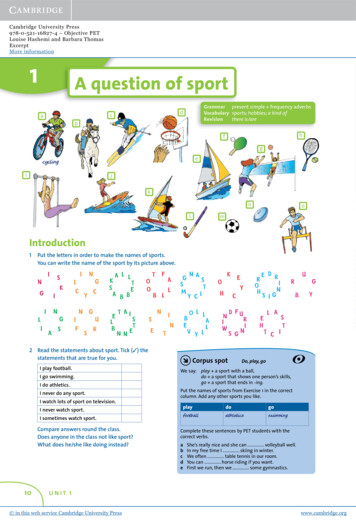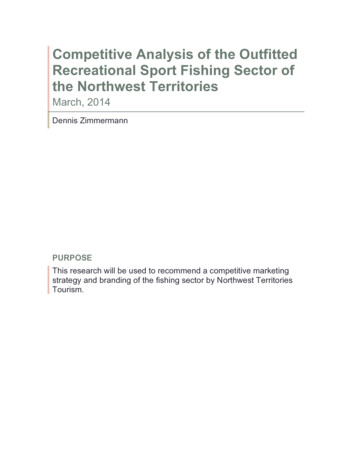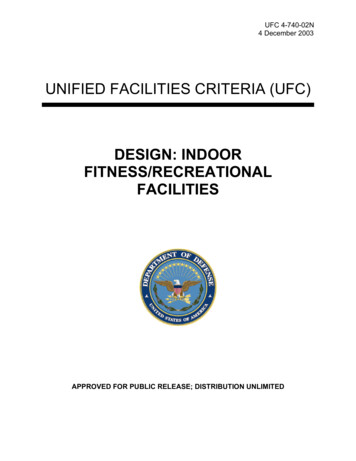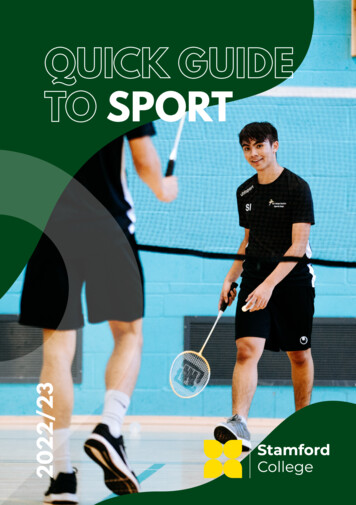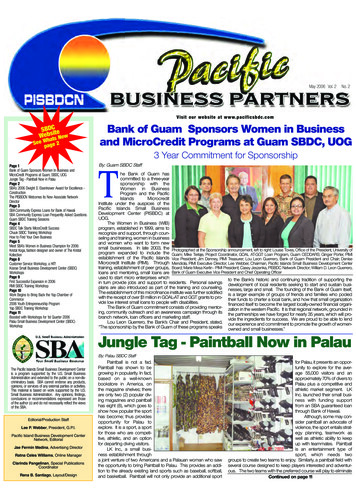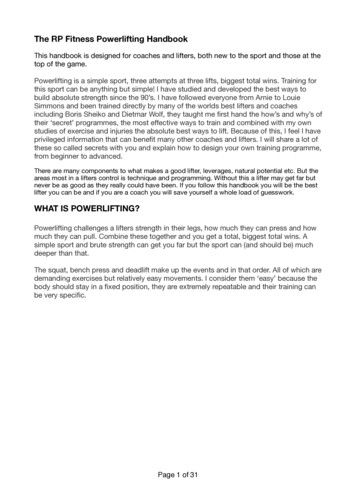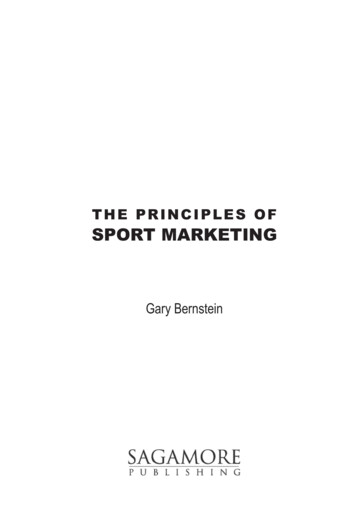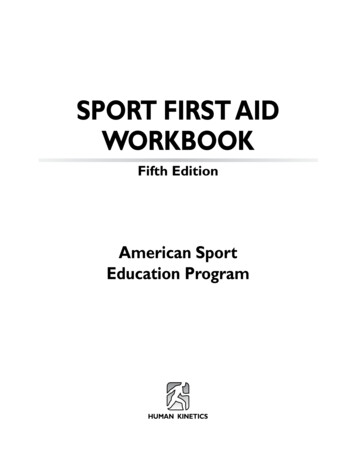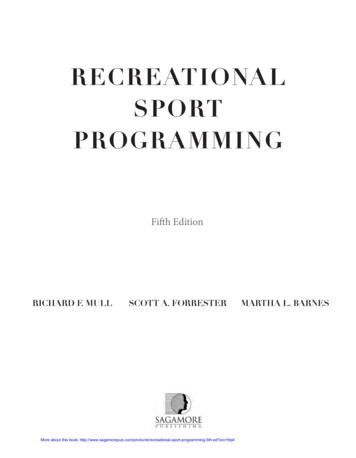
Transcription
RECREATIONALSPORTPROGRAMMINGFifth EditionRICHARD F. MULLSCOTT A. FORRESTERMore about this book: port-programming-5th-ed?src fdpilMARTHA L. BARNES
2013 Sagamore Publishing LLCAll rights reserved.Publishers: Joseph J. Bannon and Peter L. BannonDirector of Sales and Marketing: William A. AndersonDirector of Development and Production: Susan M. DavisTechnology Manager: Christopher ThompsonProduction Coordinator: Amy S. DagitISBN print edition: 978-1-57167-708-2ISBN ebook: 978-1-57167-709-9LCCN:2012952300Sagamore Publishing LLC1807 N. Federal Dr.Urbana, IL 61801www.sagamorepub.comMore about this book: port-programming-5th-ed?src fdpil
This fifth edition is dedicated to three previous authors who played essential roles in the development and evolution of thistext’s content. Special thanks and recognition go to:Kathryn Bayless, MS, Director, Campus Recreational Sports, Indiana University and Assistant Dean, School of Public Health(formerly School of Health, Physical Education and Recreation), Indiana University;Dr. Lynn Jamieson, ReD, Professor, Department of Recreation, Park, and Tourism Studies, Indiana University; andDr. Craig Ross, ReD, Professor, Department of Recreation, Park, and Tourism Studies, Indiana University.Their contributions span over 30 years and integrate significant academic and practical knowledgeof the recreational sport specialist and reflect their dedication to professional preparation and career development.More about this book: port-programming-5th-ed?src fdpil
More about this book: port-programming-5th-ed?src fdpil
ContentsPreface .viiAcknowledgments. ixAbout the Authors. xiIFOUNDATIONS.1123Identified and Realized. 3A Specialized Field. 13A Management Model. 27II VALUES AND BENEFITS.37456Fitness. 39Learning. 55Fun. 77III PROGRAM DELIVERY.9778910Instructional Sport. 99Informal Sport .119Intramural and Extramural Sport.133Club Sports.175IV RESOURCE CONNECTION. uipment.275V ADMINISTRATIVE INVOLVEMENT. 2891516171819IndexProgram Planning.291Marketing .309Maintenance.325Legal Concerns.335Career Implications .357.373More about this book: port-programming-5th-ed?src fdpil
More about this book: port-programming-5th-ed?src fdpil
PrefaceThis text has been written to help current and future recreational sports leaders, or more specifically,programmers and specialists fulfill their role as professionals. The content will support and facilitate the learningconcepts and facts as they relate to any management organization with the purpose to deliver sport as a leisureactivity. With society becoming so health conscious and activity oriented, the role of sport is increasingly beingrecognized and supported as an integral part of everyday life for so many people. Hence, this text is designedto serve this interest and contributes to the professional preparation that takes place in Sports Management/Kinesiology, Recreation and Leisure Studies, and Business. We will accomplish this by presenting recreationalsports with its unique knowledge, key techniques and methods, leading to appreciation for it as a specializedfield.Part I, Foundations, addresses recreational sports as a theoretical and practical field of study. Chapter 1,Sports Identified; Chapter 2, Specialized Field; and Chapter 3, Management Model, each presents a logicalframe of reference for complete insight to recreational sports.In Part II, Values and Benefits, we review supporting research relevant to recreational sports and its criticalrole in today’s society. Chapters 4 through 6 provide information on fitness and learning opportunities gainedthrough sports participation as well as fun as a very popular outcome from participation.In Part III, Program Delivery, we provide practical detail programming information that is relevant to anyagency that wishes to deliver quality recreational sports experiences. Chapters 7 through 10 discuss traditionalprogramming, which includes instructional sports, informal sports, intramural and extramural sports, and clubsports, all of which represent the distinctive body of knowledge that recreational sport brings to an agency andits participants.Being mindful of the academic interpretation of management and its overall role in curriculum andprofessional preparation, we will place emphasis on specific management areas and responsibilities that arejudged critical and necessary to the recreational sports professional/programmer/specialist.In Part IV, Resource Connection, we will look at the different resources and their impact on a specialist’srole. In Chapter 11, Staffing, we examine the different personnel considerations and issues surrounding thesupervision of paid and volunteer staff. In Chapter 12, Funding, we examine both income and expendituresalong with pertinent budget and accounting information. Chapters 13 and 14 review key information and thesignificance for the existence and nature of facilities and equipment.In Part V, Administrative Involvement, we provide select information where responsibilities can be integratedin any number of ways, but definitely part of everyday programming. In Chapter 15, Planning, we share theprocess of anticipating program details in order to assure the greatest possibilities for success! In Chapter 16,Marketing, we examine considerations that assess and then design efforts to attract participants. Chapter 17,Maintenance, creates awareness to details that could impact the recreational sports program delivery, an oftenbehind the scenes function related to facilities and equipment. Chapter 18, Legal Concerns, addresses the needfor security and safety measures to keep participants safe and reduce exposure to agency liability. Chapter 19,Career Implications, provides a closing that shares an overview of the nature and meaning as a recreationalsport professional as well as career significance, options, and decisions.Throughout the text we have updated the concept of career opportunities with the Shining Examples, helpingthe reader appreciate different agencies and the careers they offer. Also, at the beginning of each chapter, isa list of objectives and key concepts that signals the most important information in the chapter. Throughoutthe text, all Computer Tips have been updated. In addition, you will find examples of forms for use in dailyprogramming operations. Full-size forms are available on the enclosed CD-ROM.Although changes have been incorporated into this edition of Recreational Sports, the basic premise hasremained unchanged from the earlier editions. We have written the book for the specialist, providing informationthat will help the specialist initiate, maintain, and enhance the recreational experience for all participants. Asin the prior four editions, the number one priority is to help professionals experience success in deliveringrecreational sports. We hope this text will contribute to the field’s body of knowledge as well as the individual’sability to make a difference through recreational sports.viiMore about this book: port-programming-5th-ed?src fdpil
More about this book: port-programming-5th-ed?src fdpil
AcknowledgmentsWe are grateful for the assistance and contributions to this text from many people. In particular, specialthanks to:Donna Beyers for her editorial assistance, overall content preparation, and coordination of all thewritten material;Evan Webb, graduate student at Brock University, St. Catharines, Ontario, Canada, for his researchassistance and help with the shining examples and the instructor’s guide for this text;Bruce Hronek, Professor Emeritus, Department of Recreation, Park and Tourism Studies, IndianaUniversity, who contributed to the chapter on legal concerns;Kathryn Bayless, Director, Campus Recreational Sports, Indiana University, who developed the originalcontent for the Informal and Club Sport chapters which is mostly maintained in this edition, and editingthe content in this edition for the shining examples for Campus Recreational Sports and Club Sports;Craig Ross, Professor, Department of Recreation, Park and Tourism Studies, Indiana University, whodeveloped the original content for the Intramural and Extramural chapter, which is maintained in thisedition, and the origination of the Computer Tips throughout the text;Lynn Jamieson, Professor, Department of Recreation, Park and Tourism Studies, Indiana University,who developed the original concept and content for the shining examples; andDavid Stewart, Indiana University Custom Publishing for providing distinct copies of selected figuresin this text.Our thanks also go to the following:Vancouver Parks and RecreationCity of Welland Integrated Services - Recreation & Culture DivisionCity of Oakville Recreation and Culture DepartmentCity of Reno-Parks, Recreation, and Community ServicesIn addition, thanks to all of the contributors of the shining examples who allowed us to share their successesin recreational sport programming.Finally, we would like to acknowledge the millions of recreational sport participants—both active playersand spectators. It is toward these individuals that all efforts in the text are directed, and it is our hope that therecreational sport specialists serving them will benefit from our experience and suggestions.ixMore about this book: port-programming-5th-ed?src fdpil
More about this book: port-programming-5th-ed?src fdpil
About the AuthorsRichard F. Mull, MS, retired from Indiana University after 35 years of service. He served theSchool of Health, Physical Education, and Recreation (renamed the School of Public Health) in capacitiesas assistant professor (1972-2006); and as director of IU Campus Recreational Sports (1972-1992), HPERAuxiliary Operations; Center for Student Leadership Development; Tennis Center; and Outdoor Pool.During his IU career, Mull created the Center for Student Leadership Development, a campus-wideleadership development concept that incorporated academic courses for student volunteers from various studentorganizations. He also created a student organization, Council for Advancing Student Leadership and was asignificant influence with the development of the Student Recreational Sports Association, an active studentvoice in campus recreational sports.His numerous professional contributions to the field led to his receipt of the 1989 Honor Award from theNational Intramural-Recreational Sports Association (NIRSA). In 1994, he was inducted into the ProfessionalHall of Fame in the School of Sport and Physical Activity at West Virginia University. In 2006, Mull receivedthe Office for Women’s Affairs Athletic Award at Indiana University for his commitment to advancingopportunities for women in sport. Other awards included the Shoemaker Special Merit Award from the Divisionof Student Affairs, the Armstrong Ambassador Award from the IU Foundation, and the Student RecreationalSports Association Honor Award.Mull has served as consultant and advisor in the field of recreational sports for more than 40 years. He alsocoauthored Recreation Facility Management, a current text used in the field of recreation and leisure studies.He also served as chairperson of the NIRSA’s professional development committee, assistant chairperson ofthe NIRSA Standards Committee, and vice president of NIRSA. His contributions to this text include chapters1-3, 13, 14, and 17. Throughout his career, Mull’s special interests included professional preparation, studentdevelopment, management, and leadership.Scott Forrester, Ph.D., is an associate professor in the Department of Recreation and LeisureStudies at Brock University in St. Catharines, Ontario, Canada where he teaches courses in recreationprogramming, statistics, and campus recreation. He was previously an intramural graduate assistant and adoctoral research assistant in the Division of Recreational Sports at Indiana University while completing hismaster’s degree in Recreational Sport Administration and his Ph.D. in Leisure Behaviour. He also brieflyserved as the interim Assistant Director for Club Sports at Indiana University. He is a lifetime member ofNIRSA and currently serves on the editorial board for NIRSA’s Recreational Sports Journal and is a memberof NIRSA’s Research and Assessment Committee. He has given numerous local, provincial, state, national, andinternational presentations on various topics related to recreational sports and has co-authored more than twodozen articles on the topic. His research examines the psycho-social determinants and benefits of participationin campus recreational sports and over the years his research has been recognized several times by NIRSA’sPresident’s RSJ Award for Outstanding Writing. His contributions to the text include chapters 4, 6-10, 15, andchapter 5, co-written with Dr. Barnes.Martha Barnes, Ph.D., is an associate professor in the Department of Recreation and LeisureStudies at Brock University in St. Catharines, Ontario, Canada, where she teaches courses in community recreation, finance, and planning. Barnes received her Ph.D. in Recreation and Leisure Studies from the Universityof Waterloo. Previously, she worked as an assistant director at the Indiana University Tennis Center after thecompletion of her master’s degree at Indiana University in Recreation Administration. Her research is focusedon improving the delivery of sport and recreation in communities. Specific past projects have included understanding community partnerships, park use, sport councils, volunteer management, and networks among sportand recreation organizations. She has presented locally, regionally, nationally, and internationally for associations such as the National Recreation and Park Association, North American Society for Sport Management,xiMore about this book: port-programming-5th-ed?src fdpil
Canadian Association for Leisure Studies, and World Leisure on various topics related to community sport andrecreation. Her work has also been published in several refereed, professional journals, related to recreation andsport management. Her contributions to the text include chapters 11, 12, 16, 19 and chapter 5, co-written withDr. Forrester.xiiMore about this book: port-programming-5th-ed?src fdpil
Part IFOUNDATIONSPart I introduces recreational sports as not only an academic field of studybut a career opportunity as well. Key theories and concepts cover a variety ofpoints, including a basic description of leisure and sport, a specialized field,and a comprehensive management model fundamental to all work-relatedresponsibilities. The content is based on a logical and practical interpretationof very extensive and complicated historical information that hopefully willhelp the recreational sport specialist to have a sound, intellectual foundationto recreational sport.More about this book: port-programming-5th-ed?src fdpil
More about this book: port-programming-5th-ed?src fdpil
Identified and Realized3CHAPTER 1Identified and RealizedCHAPTER OBJECTIVESAfter reading this chapter, the reader will be familiar with basic recreational sport terminology,understand the divisive and unifying aspects of sport, understand the leisure sport management model,and be able to describe the four sport management areas.KEY ealthLeisureRecreationSportIntroductionFundamental to any subject is understanding andappreciating its meaning by learning relevant termsand concepts that support its entity. Recreationalsport is a subject as well as a professional undertaking that requires a description because its identity andreality have encountered a moderately confused anddiverse interpretation. Terms used to describe recreational sport include physical activity, recreationalprogramming, intramural sport, physical recreation,and athletics; however, these terms do not adequatelyrepresent everything that recreational sport encompasses. In most settings, the definition of recreationalsport lacks uniformity, consistency, and accuracy—all of which are necessary if recreational sport is tobecome a viable professional subject.Consistent language that reflects the true natureof recreational sport is needed. Toward that end, thischapter presents past efforts to define sport, followedby a discussion of popular terms, including a varietyof relevant concepts. Finally, a unified definition ispresented, based on the four distinct sport management areas of the leisure sport management model.ActivityGame formLeisure sport management modelSport management areasThis chapter is intended to help identify recreationalsport as an important subject with both practical andacademic substance.Basic ConceptsTo explore the foundation upon which recreational sport stands, it is necessary to take a closelook at four key subjects: health, leisure, recreation,and sport. Each of these subjects has a social, cultural, and economic influence on society. Health,leisure, recreation, and sport are the foundation forrecreational sport.HealthHealth is described as a state of physical, mental,and social well-being that might also include spiritualpractices. Its discussion includes the mind and body,and its general condition can encompass a variety ofpositive and negative circumstances that can impactone’s overall health.More specifically, mental health is the measureof an individual’s emotional and psychological wellbeing and how he or she is able to use cognitiveMore about this book: port-programming-5th-ed?src fdpil
4Recreational Sport Programmingand emotional capabilities to function in society.Central to this is the human brain at the helm ofthe central nervous system. On the other hand,physical health describes the status of bodily partsand functions that allow an individual to navigatehis or her environment efficiently and effectively.It requires the seamless integration of all bodyparts and systems to function properly. Good healthrepresents freedom from disease and abnormalities,hence the medical, education, and practical practiceof fostering healthful living.These definitions overlap and contribute to theoverall concept of health and its integration intothis text. Areas such as sleep, hygiene, nutrition,recreation, and exercise combine together to facilitatehealthy living. Such activities involve one’s personalcare, practices, and use of leisure.LeisureLeisure can be categorized into two broad categories: qualitative and quantitative. The qualitativeconcept of leisure, exemplified by the early writingsof Aristotle on the Greek upper class, perceives leisure as an expression of superior spiritual activitiesof the mind and body. This school of thought holdsthat leisure is a state of being in which people are freefrom biological or work constraints. The individualfocuses on contemplation and reflection of activitiesonce reserved for the highly educated, or the upperclass. Today, education is no longer restricted to theupper class, so less emphasis is placed on leisure asa state of being.The quantitative school of thought views leisure as discretionary use of time. Human functionsare grouped into three types: personal care, work,and leisure. Personal care refers to time spent eating, sleeping, or attending to personal maintenanceand bodily functions. Work is time spent training fora vocation and participating in gainful employment.Leisure is unobligated time spent participating in activities of personal interest. Its meaning is well documented, and it is a significant subject that is highlyvisible and easily recognizable. During leisure timeindividuals have the opportunity to choose to participate in an activity that ideally is positive, constructive, and healthy—recreation.RecreationRecreation is often defined as voluntary activitythat creates a diversion from work. It is a reenergizing,socially acceptable use of leisure time. Recreation isa leisure-time experience during which the choicesand expected outcomes of participation are left to theindividual. The goal of recreational management isto provide participants with a variety of activities tochoose from and to help participants have positiveexperiences.People all over the world pursue a variety ofleisure-time activities, making recreation a broadterm. In addition, each leisure activity can have itsown specialized areas of study. To move towardidentifying recreational sport as a leisure-timeactivity, it is important to review the types of activitiesthat recreation encompasses.Social activity. Social activity is a broad categoryof recreation that fosters congenial, noncompetitiveparticipation among people sharing a commoninterest. It emphasizes human interaction and oftentakes the form of parties, dances, conversation,dining, and other social activities.Cultural activity. Cultural activities provideopportunities for individuality, creativity, and selfexpression: Art focuses on creating aesthetic objects. Examples are painting, woodworking, sculpting, andcrafts. Dance, such as folk, square, modern, or ballet,focuses on rhythmic patterns in movement. Drama is storytelling in a theatrical presentation. Literary, mental, and linguistic activities emphasize mental challenges and include reading,working puzzles, learning languages, and writing. Music involves vocal and instrumental expression of sound that possesses rhythm, melody, andharmony.Outdoor activity. Any leisure activity experienced in the outdoors is considered an outdoor activity, but what distinguishes this type of activity isits emphasis on what the environment brings to theactivity. The activities most often associated withoutdoor leisure include hiking, camping, mountainclimbing, spelunking, rafting, backpacking, cycling,boating, skiing, and snow sledding.Garden activity. The garden is often seen as aplace of peace and tranquility. Gardening activitiesfocus on planning, implementing, and maintaininga plot where herbs, fruits, flowers, or vegetables arecultivated. Many participate in gardening activity forits therapeutic benefits of relaxation and distractionfrom work.Fitness activity. Fitness activity involves activities whose main goal is to improve physical health.The list of fitness activities is seemingly endless withMore about this book: port-programming-5th-ed?src fdpil
Identified and Realizedjogging, cycling, swimming, and walking being themost popular.Faith-based activity. Many people spend alarge portion of their leisure time engaged in faithbased activities. Faith-based activities are based onreligious or spiritual practices. They often involvegroup participation in celebratory or serviceoriented events, such as weekly worship services,choir practice, soup kitchens, and internationalmission trips. Faith-based activities also encompassindividual activities such as prayer, meditation, andstudy.Hobby activity. A hobby is a leisure activityinvolving a personal interest. Hobbies include collecting, constructing, or pursuing objects of specialinterest; examples are stamp and coin collecting, antiques, crafts, photography, bird-watching, and traveling. Hobbies are self-proclaimed areas of interestthat often overlap with the other types of leisure activity.Special-events activity. Special events is acatchall category that includes activities that involvea change of pace in a unique or nontraditionalformat. Special events may be short term, ongoing,or seasonal and include fairs, concerts, and openhouses.Sport activity. Sport is everywhere, reflectingmany facets of the world’s cultures. It ranges froma child’s frolic and play to an athlete’s vigilance inpreparing for the Olympics to an executive creatinga healthy lifestyle through sport participation to anadolescent watching sports on television. As a formof recreation, sport has been shaped by tradition,popularity, and potential for profit. It has evolved andprospered to the extent that it plays a major role ineveryday life.Figure 1.1 diagrams the health, leisure, recreation,and sport progression, or how basic human existenceleads to sport activity as recreation. As this chaptercontinues, it will build a foundation of terms thatdescribes sport and provides a solid framework forunderstanding sport as a healthy form of leisureactivity.Human existenceSocial activityHealthCultural activityPersonal careOutdoor activityGarden activityWork/trainingFitness activityLeisureRecreation5Faith-based activityHobby activitySpecial-events activitySport activityFigure 1.1. Establishing the Existence of Sport ActivityMore about this book: port-programming-5th-ed?src fdpilFigure 1.1 - Establishing the Existence of Sport Activity
6Recreational Sport ProgrammingExploring SportFor decades, the definition of sport has beenunder debate, resulting in a variety of interpretationsand professional and scholarly polarization. Scholars,schools, and agencies have staked out their particularintellectual territory by describing and applying sportas a means to some particular end. The subsequentconfusion has resulted in linguistic and conceptualinconsistency as well as a myopic view of sport, andit has restricted the development of the recreationalsport movement. The following material presents aunified management approach to all areas of sportand consistent terminology that provides a platformfrom which all factions can begin to work together.Discerning ApplicationsSport has been around since the beginning ofrecorded time. Countless books have been writtenon the history of sport, and it is a complete area ofscholarly study. Unfortunately, as sport has evolved,its true meaning has been distorted because ofvaried forms of interpretations and inconsistentapplications. It could be observed that only thegifted have the opportunity to fully benefit fromthe many ways sport promotes human growth anddevelopment. Less gifted participants often havebeen rele
of NIRSA’s Research and Assessment Committee. He has given numerous local, provincial, state, national, and international presentations on various topics related to recreational sports and has co-authored more than two dozen articles on the topic. His research examines the
